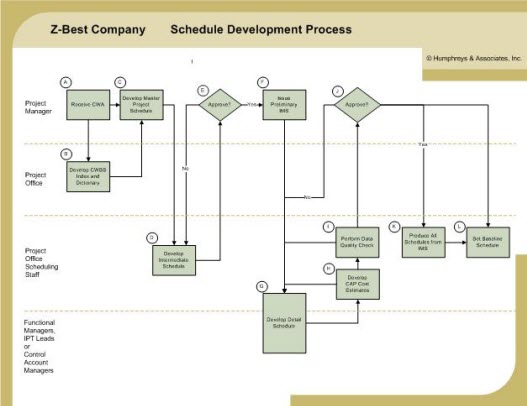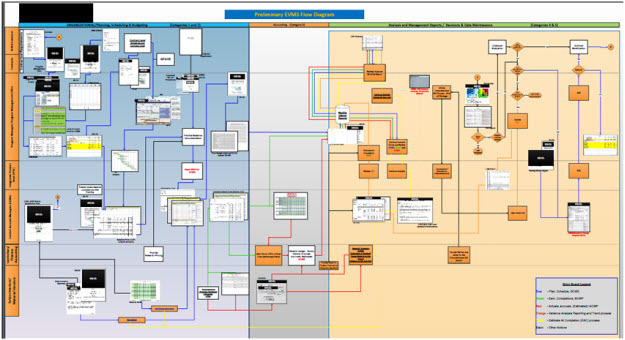Storyboards have been around since the dawn of humans and are still used today as effective communication tools. The early storytellers etched and painted images on cave walls, temple pillars, and tombs. A Google search today would find countless references to storyboards, which have many uses ranging from film making to application development as well as simple story telling.
Film director George Bloom sets the stage nicely – he once said, “Storyboards saved my life more than once in meetings…cuts through all the talk.” In his paperback book, Rapid Application Prototyping (Oct 1991), Stephen J. Andriole extols storyboarding as a “…method for systems requirements validation…use these displays to validate user requirements as well as to size the subsequent system development process.” This is a fitting introduction for how storyboarding can benefit a company in the development and maintenance of an earned value management system (EVMS).
The EVMS Storyboard: An Overview
An Earned Value Management System Storyboard depicts the entire management system as stratified flow diagrams with artifacts illustrating the inputs and outputs that demonstrate the system in operation. These stratifications illustrate the “who does what to whom” element of an EVMS process, pointing out the interactions of the various functional organizations on a project throughout the EVMS cycle.
Storyboards can take many shapes. The entire process can be displayed on panels or poster boards on a conference room wall. It can be contained in the EVM System Description document as an overall flow or as segmented flows in the system description sections corresponding to the process flow. It can also be online flow diagrams with links to live artifacts.
The stratified flow diagrams typically depict the nine process groups, as defined in DCMA’s Earned Value Management Implementation Guide (EVMIG). This includes Organizing (the work), Scheduling, Work/Budget Authorization, Accounting, Indirect Management, Managerial Analysis, Change Incorporation, Material Management, and Subcontract Management. Alternatively, the storyboards can be set up to address the five major EIA-748 32 guideline categories of Organizing; Planning, Scheduling, and Budgeting; Accounting; Analysis and Management Reports; and Revisions and Data Maintenance.
The goal of an EVMS Storyboard is to clearly illustrate how the entire system functions (the flow), who is responsible for doing what (decision points and actions), products (forms, reports, and other artifacts), and how all the process groups are interrelated to create a fully integrated EVMS. The storyboard should illustrate a single thread trace to demonstrate data integrity from beginning to end using actual project artifacts. It can be an essential tool for training all levels of users and also for demonstrating to a customer how the contractor’s EVM System functions.
The Scheduling process group is an example of one of the process groups. One schedule “story” is the development of the schedule baseline in a logical sequence of events and activities involving company and project line managers, team members, functional managers, and system users, while clearly illustrating the respective responsibility and/or action of each organization in the process. This process may only include internal organizations, but could also include external organizations – an example would be the steps to incorporate subcontractor schedule data.
An example of a stratified flowchart for just the schedule baseline development process is illustrated below.

To convert the above flowchart to a storyboard, the company would replace many of the flowchart blocks with pictures of actual documents used on the project as evidence of accomplishing the steps. In the above example, the company could substitute documents for all the blocks except E, J, I, and L.
A sanitized example of a stratified storyboard of a company’s EVM System is shown below. This contractor has incorporated hyperlinks for each of the documents in the system flow so that the reader/reviewer can click on the document and have the example document appear online. The CAM or other manager can then navigate from that point to the specific file to show the actual documentation for their control account.

While a company’s total operation will involve company staff and support organizations needed to fulfill corporate obligations, regulations, accounting codes, contract stipulations, etc., it is not required to have all these organizations appear on the storyboard stratification. The storyboard is meant to depict the organization that has been set up to manage the particular project, and organizations like Marketing, Legal, and Human Resources, etc. will not normally appear in the stratification swim lanes on the left border of the flow diagram.
Goals for the Storyboard Development
As with any process design, one of the goals is to develop a logical sequence of events along with the involvement and actions of participants or decision makers which results in a complete process. This is absolutely essential so that there are no misunderstandings, uncertainties, or potential conflicts of authority. Storyboard development involves multiple iterations and internal tests to demonstrate that the:
- Flow of products truly reflects the way the company/project team conducts the day-to-day operations involving the organizations noted in the flowcharts in a clear and precise manner. The goal is to eliminate products or processes that are out of date or not used, do not make sense, or, in some cases, are pure window dressing. Ambiguous or contradictory authorities, responsibilities, and actions can doom the usefulness of the EVMS, as eventually, management energy and commitment to the process are lost.
- Levels of management depicted in the flowcharts achieve consensus in their respective responsibilities and that they will respond as indicated in a timely manner. The intent is to demonstrate the understanding and commitment of those managers shown on the storyboard.
Often during the actual construction of the complete storyboard, a company uncovers outdated processes that are no longer functioning as initially intended and need to be replaced or revamped. In these cases, upper management commitment to the process is essential. Recognizing the gaps in the system and filling those gaps with revised processes results in a storyboard that is an accurate and comprehensive depiction of the corporate EVM System. Without complete management support of the system and all its component parts, it will be doomed to failure. And, a system that does not exhibit compliance with the EIA-748 EVMS requirements will not pass government scrutiny.
Another goal of storyboard development is to eliminate the products and processes that do not add value or make it harder to maintain data integrity. If the storyboard does not accurately illustrate the process, responsibilities, actions, and products, it needs more fine tuning until all system users own and support the end result. As a result, the storyboard will clearly show how the respective participants on the project support project planning and control in a logical sequence. The EVMS Storyboard development should result in the overall improvement of the project control systems as well as the internal and external communications processes.
Storyboard Benefits
Storyboarding earned value management systems has been an on-going process since the late ‘60’s, when contractors were asked to demonstrate their EVM systems to government review teams. The storyboard is a quick way for a contractor to communicate to a government review team how the company EVM System operates on a given project.
Construction of a company’s EVM System Storyboards in the stratified format, whether to the nine process groups or to the five guideline categories, frequently uncovered various disconnects in the integration of the processes, missing features and/or requirements, and also misunderstandings of roles and responsibilities. Contractors and customers alike soon recognized the benefits of storyboarding these process groups. Contractors were able to update their internal training programs to address those disconnects, and customers were provided more accurate system presentations during their project review in-briefings.
Examples of some of the benefits for developing an EVMS Storyboard include:
- The ability to demonstrate that the entire system actually exists, the process groups are integrated, and the roles/responsibilities of control account managers (CAMs), integrated product team (IPT) leads, functional managers, project managers, project control teams, contracts, finance, accounting, and other business managers are clearly depicted.
- Individual processes can be quickly traced among the process groups quickly and easily with examples of live data.
- The contractor can easily demonstrate to internal system users and all levels of management, as well as to its external customers, how the entire system functions. This is useful for training, verifying system processes, conducting briefings, and increasing customer satisfaction.
- It is a valuable exhibit during pre-award surveys, proposal development, and other source selection activities. The contractor can demonstrate it has a robust project control system in place, thus enhancing award rates.
- The storyboard can help transform abstract concepts into something more tangible. The system users gain a better understanding of the system interfaces, those responsible for doing the “what and when” of the processes, and the expected products for each step. Live examples illustrate data expectations as well as help confirm data traces between artifacts, emphasizing the importance of data integrity throughout the process.
- Consensus reached during the storyboard development process can help eliminate out dated subsystems and streamline cumbersome ones, thus encouraging wider use and acceptance of the system.
Current Trends
With the variety of software tools available for scheduling, cost management, and reporting, industry appeared to be moving away from developing EVMS Storyboards. “We’ve gone paperless – why do we need storyboards?” Contractors used various online methods to provide data to reviewers, but those reviewers indicated they still needed a map to guide them through the myriad of data provided in a typical data call. The “old fashioned” storyboards provided a map that told the reviewers where to look for the data they needed to answer their questions on system compliance.
This apparent trend away from storyboards now seems to have reversed, as several DCMA review teams continue to expect contractors to have EVMS Storyboards in place to assist with their data tracing tasks. Generally, this is done during the review in-briefing to the team, but some contractors provide a version of the storyboard to the DCMA team for their use throughout the review process. This helps the DCMA review team work through their questions about system documentation in their team room instead of writing Discrepancy Reports (DRs) or Corrective Action Requests (CARs) because they don’t know how to locate certain documents.
This is a huge benefit to contractors, since it can help avoid unnecessary findings. During the various EVMS reviews, project managers, business managers, CAMs, and others are often expected to use the storyboard as at least the starting point in walking the reviewers through a given process using live artifacts. The storyboard helps them to tell their “story” and demonstrate data traceability.
Earned Value Management System Storyboards have been proven to greatly facilitate internal and customer understanding of the entire system. It is a useful exhibit to show anyone how all the EVMS processes function, how they are integrated to facilitate data integrity, and who is doing what when. People manage programs and projects, and the system is there to support that process. Storyboards are the perfect tool to support the management process.
|
|
Download this Article as a PDF |